Catalogue > List by artist
Browse the entire list of Rencontre Internationales artists since 2004. Use the alphabetical filter to refine your search. update in progress
Bosse Sudenburg
Catalogue : 2007TheNewYorkPerfermance | Experimental video | dv | color | 7:30 | Germany, USA | 2005
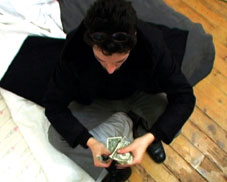
Bosse Sudenburg
TheNewYorkPerfermance
Experimental video | dv | color | 7:30 | Germany, USA | 2005
"TheNewYorkPerformance" is a three-part video performance. In "100 Bucks in 100 Seconds" we can see the actor counting 100 dollars in 100 seconds, every second a banknote in 100 different camera shots. Time passes, sometimes slower, sometimes faster. The measure of time corresponds to the amount of money, but the time actually lived escapes the cut, which makes life immeasurable and prompts us to question ourselves about its subjective value. The obsessive verification of its own solvency - as he counts his money in every shadowy corner of the towers in New York's financial district - is the self-phasing of "Real Time", which allows everyone around the world to react within a second, with the same method, to the cyclical variations in the diamond mines of Congo just as in the rice fields of Vietnam. This video is driven like a film-rhetorical experimentation between the intuition of phenomenological space and the illusion of its stereometric unit. The scanning of the camera shots reveal that this unity is a production of the perceptive habit of the viewer and frees the eyes, giving them back their original perception of space. In "Leftwing", the artist transforms a typical school desk by sawing off the right half to reassemble it on the left. After finishing his work, he sits down on the chair, signs the table and, after due consideration, sticks a chewing gum under it. What the video shows, however, is not the already transformed desk, but the transformation process itself. The documentary camera, held far back from the shot, thus makes us forget that the real product, the work presented here, is neither an object nor the story of its creation, but a succession of digital images. The real work escapes attention: it is the different aspects of the nature of this work that are explored here. The action of sticking the chewing gum to the desk highlights the action of signing the desk, which here is brought to the level of graffiti and "TAGS". The conscious appropriation of everyday´s environment is opposed to the integration of the artistic work in an artistic context. In this context, the title provocatively poses the question of the importance of politics in Art. Art is seen as a field of experimentation of aimless transformations - underlined in the reassembling of the desk and the clumsiness of the actor. In "Studio 510 Blues" we see the artist enter his studio apartment, look around and finally grab a worn-out and torn shoe in order to spray the gape with red color. At the rhythm of the song "Running Blues" by the Doors, he uses the shoe as a puppet and imitates the singer, with the gap between the sole and the shoe as the mouth. In this video the actor works with his personal relationship with New York City, where a scholarship allowed him to live and work for six months. As the traces that he was able to leave in the city slowly fade away, the city carves itself into its residents in a form of erosion. The erosion of the shoe symbolizes the erosion of time. The quality of this time, made up of all the lived moments, leads to loading the shoe with nostalgic memories. Through the derisory nature of a holed shoe, the actor alludes to the difference that exists between the European identity with its overflowing history and the American identity in its pragmatic trend. The separation between the thing and its purpose, by extracting the shoe from its usual context, should be understood as an invitation to the creative handling of one's own perception, which contains the possibility of an interaction between the individual and his environment, and, furthermore, returns to the possibility of making it the seat of its own identity.
The artistic journey of Bosse Sudengurg commences in 1996 when he began his studies of art and cultural history in Leipzig. Through contact with a group of artists called "Ramon Haze", he quickly finds himself more interests by the practice than by the artistic theory, which doesn't stop him from during his studies developing a critic's eye and analytic look on art, ever present in his works. In 1996, the artist was still exclusively working in the domain of plastic. His meeting of Ilja Kabakow, who is exhibiting this year in Leipzig at the Gallery of Contemporary Art, lead him to contribute to "Blind Date", the first exhibition of "Ramon Haze" that confronts the relationship between the body and space. It was in the following year that "KommunikationNonKommunikation", relative to space, was born. In this cinematic work that leaves sculpture behind, the artist finds a medium that continues to mark his works even today. The dematerialisation of the artistic object that intervenes here, with, in the background, the digitization of the flow of datum and the development of the internet, presents itself as an attempt to demystify the image transmitted by the media. According to the famous axiom from Marshall MacLuhan, which is regaining popularity, "the medium is the message", the artist attempts to conceal his personal identity from the danger of being carried away with the flood of data and to emerge only as a manifestation of the changing fashions in mass media. This is how the work entitled "KommunikationNonKommunikation" serves, in the evolution of the artist, as a passage towards occupation of his own person. The return to self is reinforced by the end of the euphoric period consequential to the fall of the wall in former Eastern Germany, where for years a horizon of immeasurable possibilities stretched out and where the general acceptance of over-consumption had led to a loss of aesthetic values down to the minutest of details. Bosse Sudennurg moved to Berlin where he studied at the experimental film at the UdK (University of Art) under Heinz Emigholz and Stan Douglas. In 2002 saw the birth of work in which autobiographical elements are manipulated to form fictitious auto-portraits as in the film "Me Myself and I", a sort of auto-interview where the actor is both the subject and the object of the camera, and the one who finalizes the shots while editing. The second important element in his way of travelling is consequently the performative. Another important film from this time is "25% ofHomeSweetHome", in which self-questioning is extended to the family. By opposing unchanging rituals, like setting an empty table, with occasional rituals, like unscrewing a bell, the artist attempts to retain the psychological state in the change. After a period of theoretic confrontation with artists like Vallie Export, Cindy Sherman, Roman Signer, Bruce Nauman, and Wolf Vostel, as well as with the "New German Film", the cooperatives of films in England or the experimental American (Maya Deren) or French (Chris Marker) film, the work "Das Letzte Einhorn" came to life in 2004 during a residency in Bristol (UWE). With the help of a pencil in front of his forehead, the actor draws a black line on a white wall. The artist as a person fades away and in this way underlines the conceptual aspect of doing and seeing. The camera, the performative, and the conceptual are the three main components of the three-video work that was created under the name "TheNewYorkPerformance" during a residency at Hunter College in New York. With another residency in New York, thanks to a scholarship from DAAD, and nominated for SaarFernGas AG's art award, Bosse Sudenburg regularly takes part in exhibitions in his homeland as well as abroad.
Ichiro Sueoka
Catalogue : 2007Ein Sommer in Deutschland | Experimental film | 16mm | black and white | 7:0 | Japan | 2005
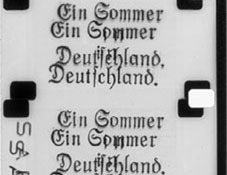
Ichiro Sueoka
Ein Sommer in Deutschland
Experimental film | 16mm | black and white | 7:0 | Japan | 2005
The most recent in a series of films Sueoka has made by reprinting the amateur films of an anonymous Japanese diplomat who was stationed in Berlin in the early 1930's. The original film attempts an idyllic depiction of a summer spent abroad; its re-presentation is an artefact of pre-war life in Germany and, in the gloomy indication of the coming autumn, a hint at darker days to come.
Ichiro Sueoka was born in Sapporo in 1965 and is now a filmmaker in Tokyo. She studied chemistry at the Tokyo University of Science and began making films in 1985. Of the 80 films so far, many were produced on Super-8. She is a co-founder of the "FMIC" (Film Makers Information Center) experimental film/video group, which since 2002 has curated and presented several screening events of the independent film-maker's works in Japan. Sueoka currently teaches film-making at Asagaya Art College and hand-developing workshops in several art schools and galleries in Japan.
Jesse Sugarmann
Catalogue : 2015We Build Excitement | Video | hdv | color | 3:35 | USA | 2013
Jesse Sugarmann
We Build Excitement
Video | hdv | color | 3:35 | USA | 2013
We Build Excitement is a serie of performances and videos examining the evolution of the American auto industry as a parallel to shifting American identity. Starting two years ago, Sugarmann opened (and plans to continue opening) unsanctioned Pontiac dealerships in former Pontiac dealership locations across the United States. He activates these dealerships as sites of celebration, honoring both the American auto worker and our fraught, intimate relationships to cars themselves. Assembling temporary modernist monuments with Pontiac cars, Sugarmann gives form to the precarious nature of the auto industry. And in video works, he documents laid-off assembly line workers and car accident victims recreating the movements of their former jobs and crashes, respectively. Their deadpan choreography forms a moving homage to the mundane and the traumatic moments in both the birth and death of the automobile.
Jesse Sugarmann is an interdisciplinary artist working in video, performance, sculpture and fibers. His work engages the automotive industry as a manufacturer of human identity, accessing automotive history as an index of both cultural identity and social history. Jesse has exhibited work both nationally and internationally in venues such as the Getty Institute, Los Angeles; el Museo Tamayo, Mexico City; the Portland Institute for Contemporary Art, Oregon; the Banff Center, Canada; Filmbase, Ireland; Human Resources, Los Angeles; Michael Strogoff, Marfa; el Museo de Arte Moderno de Santander, Spain; Drift Station, Omaha; Fugitive Projects, Nashville; the 21c Museum, Louisville; and High Desert Test Sites 2013. His work has been written about in publications including ArtForum, Art Papers, ART LTD, Art Cards, Art Fag City, Art Car Nation, Frieze Magazineand The New York Times. Jesse lives and works in Bakersfield, CA.
Matthew Suib
Catalogue : 2006Cocked | Art vidéo | dv | color | 10:0 | USA | 2003
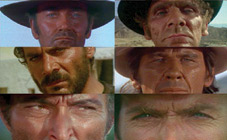
Matthew Suib
Cocked
Art vidéo | dv | color | 10:0 | USA | 2003
Produced during the peak of international debate regarding the United States? initiative to invade Iraq, COCKED is an anti-war statement in the guise of a minimalist Western, borrowing dozens of short segments from several Cinema classics of the genre. COCKED expands and sustains what is usually a brief, tense, cinematic moment--the showdown--and implodes the classic American mythology of the Western. As this extended psychodrama plays out, the classic desert panorama characteristic of the Western?s cinematic space is collapsed into a metaphoric psychological space, where every gesture, glance and posture, communicate a mixture of aggression and fear, and nothing is resolved
Philadelphia-based media artist Matthew Suib has exhibited installations, video and audio works and photographs internationally at venues including the Philadelphia Museum of Art, the Institute of Contemporary Art (Philadelphia), Kunstwerke (Berlin), Images Festival (?02, ?05, Toronto), and PS1 Contemporary Art Centre (NYC). Most recently, his work Cosmic Microwave Background with New Humans was exhibited in collaboration with Brooklyn-based collective New Humans at Apex Art (NYC). He is also a member of the Philadelphia artist-cooperative Vox Populi.
Arya Sukapura Putra
Catalogue : 2014E-Ruqyah | Video | hdcam | color | 2:8 | Indonesia | 2013

Arya Sukapura Putra
E-Ruqyah
Video | hdcam | color | 2:8 | Indonesia | 2013
Arthur Summereder
Catalogue : 2025A few remarks on logistics in general | Documentary | hdv | color | 16:0 | Austria | 2023
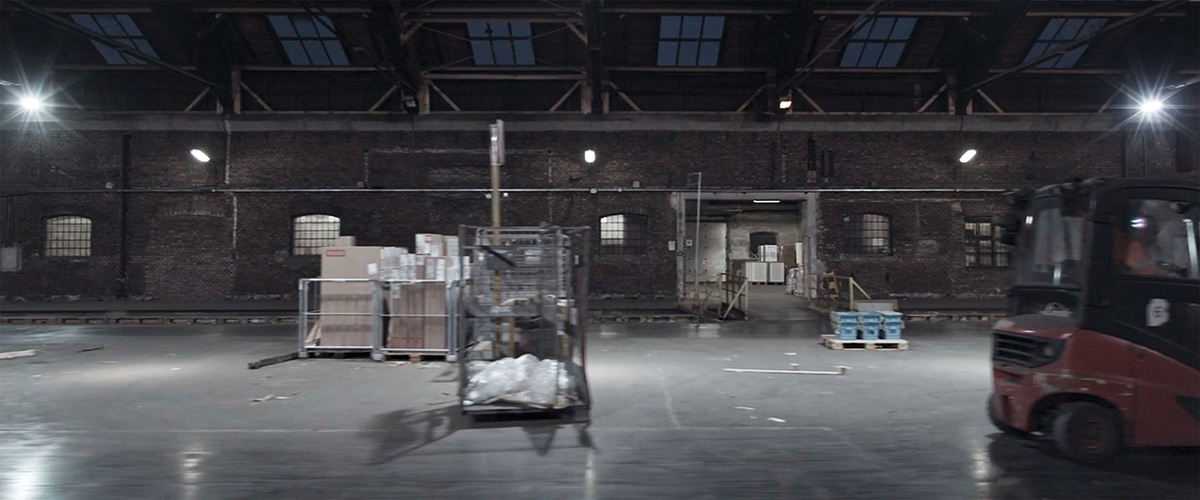
Arthur Summereder
A few remarks on logistics in general
Documentary | hdv | color | 16:0 | Austria | 2023
Der Titel A few remarks on logistics in general verweist auf eine Kapitelüberschrift in Antoine-Henri Jominis militärtheoretischer Schrift Précis de l'art de la guerre, aus 1983. Darin legt er den Grundstein für einen „oeconomic turn“ in der Kriegsführung indem er in aller Deutlichkeit darauf hinweist, dass zukünftig überlegene Nachschubrouten der entscheidende Faktor zum Sieg sei. Kriege würden folglich durch bürokratische Akkuratesse und weniger durch Tapferkeit, Heldenmut und strategisches Geschick gewonnen. Eine folgenreiche Erkenntnis, die auf dem Weg zur allgemein anerkannten Militärdoktrin auf Widerstand stieß. Liegt darin doch eine kränkende Abwertung des Einzelnen vom Soldaten bis zum General durch eine Perspektive, die weniger mit dem Wirkungsbereich und dem Schicksal von einzelnen befasst ist, als mit systemischen, strukturellen Zusammenhängen und Funktionen. In der zweiten hälfte des 21. Jhdts wurde diese logistische Wende auch für den ökonomischen Wettkampf zum totalitären Paradigma, zur Basis des globalisierten Neoliberalismus, superior Supply Chain über alles. Eine der Fragen die diesen Video-Essay motiviert ist, wie sich eine solche Perspektive ohne Held*innen in ihrem Blickfeld, ins Kino übertragen lässt. So zeigt der Film weniger einzelne Handlungen als deren choreografische Verzahnung, etwa ein Staplerfahrerkollektiv bzw. -Balett.
Regie/Produktion/Kamera: Arthur Summereder Biografie: Arthur Summereder, geboren 1983, lebt und arbeitet in Wien und Heiligenkreuz im Wienerwald. Er ist Filmemacher, Filmeditor, bildender Ku?nstler und PhD Researcher (Kunstuniversita?t Linz). In seiner Arbeit bescha?ftigt er sich insbesondere mit dem Verha?ltnis zwischen filmischen Repra?sentationen nicht- filmischer Wirklichkeit sowie in ju?ngerer Zeit mit Aspekten von Mobility Studies und Metapherntheorie. Er studierte Film und Kunst im o?ffentlichen Raum (u.a. an der Akademie der bildenden Ku?nste Wien, Villa Arson, Nizza), lehrte im universita?ren Bereich in O?sterreich und China. Seit 2011 arbeitet er als Cutter von vorwiegend Kino-Dokumentarfilmen, 2019 erhielt er den Preis fu?r Dokumentarfilm-Montage der Diagonale - festival des o?sterr. Films; 2021 erschien sein Langfilm- Regiedebu?t Motorcity
Kim Sungeun
Catalogue : 2013A Voyeur?s Diary | Experimental doc. | hdv | color | 23:19 | Korea, South | 2013

Kim Sungeun
A Voyeur?s Diary
Experimental doc. | hdv | color | 23:19 | Korea, South | 2013
Can Sungu
Catalogue : 2016Replaying Home | Video | hdv | color | 30:0 | Turkey, Germany | 2013
Can Sungu
Replaying Home
Video | hdv | color | 30:0 | Turkey, Germany | 2013
In the early 1980s, VHS video recorders had become widespread in Germany and in a very short time they were also well accepted by many Turkish immigrants there. The lack of sufficient German language skills, as well as the fact that the content of German television broadcasting was not targeting the Turkish audience at all, led Turkish immigrants increasingly to rent videotapes. The video nights were a sort of social event including neighbours and family. Watching videos was accepted as a pleasant and family-friendly alternative to going out and getting attached to German-dominated cultural life. A lot of Turkish video companies opened up in Germany and imported movies to transfer them on videotapes. Some of these companies also produced low-budget video movies targeting the Turkish audience in Germany. Due to digital revolution, these companies were not able compete against digital TV and online videos and closed one after another. Some of the movies which were only released on videotapes, are now in danger of disappearing forever. Replaying Home is a video collage including selected cuts from these Turkish movies shot in Germany during the 1970s and 1980s and invites on a journey through a fictive universe based on stereotypes, culture shock, Occidentalism, homesickness and the traumas of migrant life.
Can Sungu was born in Istanbul, Turkey, studied Film (BA) and Visual Communication Design (MFA) at Istanbul Bilgi University and at the Institute for Art in Context in Berlin University of Arts (MA), gave courses on film and video production, facilitated workshops and took part in various exhibitions in Europe, such as at transmediale`14, Museum of Modern and Contemporary Art Rijeka and Künstlerhaus Vienna. In 2014 he co-founded the project space bi`bak in Berlin-Wedding where he works as project manager, artist and curator.
Outi Sunila
Catalogue : 2013Platoon | Video | hdv | color | 7:40 | Finland | 2012
Outi Sunila
Platoon
Video | hdv | color | 7:40 | Finland | 2012
Blind soldiers are groping their way through a forest. Tight group is slowly shattered, leaving each man alone in the darkness.
Visual artist Outi Sunila (b. 1970) works mainly with video and installation art, experimenting with other media as well. For the past few years she has been focusing on both social and political themes in her works ? from the viewpoint of an individual. Her language is narratively minimal, portraying one scene without dialoque. She loads the scene and actions with symbolic values through which the story is told. Her works have been recently shown at exhibitions in MUU Gallery, Helsinki and S?rland?s Art Museum, Norway, as well as at festivals and screenings; FestArte Video Festival in Milan and Rome, Kakelhallen in Mariehamn and Waterpieces Festival in Riga. Sunila has works in collections of both Oulu and Helsinki Art Museums and Kiasma Museum of Contemporary Art. Outi Sunila (b. 1970) is currently living and working in Helsinki, Finland. She graduated in 2002 with an MFA from the Finnish Academy of Fine Arts, and in 2005 with an MA from University of Art And Design, Helsinki.
Jeanne Susplugas
Catalogue : 2014Iatrogène | Experimental video | hdv | | 10:0 | France | 2013
Jeanne Susplugas
Iatrogène
Experimental video | hdv | | 10:0 | France | 2013
En 2006, Jeanne Susplugas commande un texte à l?écrivaine Marie Darrieussecq, lié à ses préoccupations. Marie Darrieussecq répond par un dialogue à trois, à la fois personnel, absurde, drôle et grinçant. Un des personnages a des malformations liées à la prise de Distilbène par sa mère pendant sa grossesse, comme l?écrivaine elle-même qui est par ailleurs l?image publique des enfants distilbène. Le film a été tourné au Café de Flore à Paris comme un hommage à la littérature et souligne le lien que l?artiste entretient avec celle-ci.
Jeanne Susplugas, née à Montpellier en 1974, vit à Paris. De la vidéo à la photographie, de l?installation au dessin, Jeanne Susplugas évolue dans un univers aussi séduisant qu?inquiétant avec comme préoccupations principales nos addictions et autres aliénations. Son travail a été exposé notamment au KW à Berlin, à la Villa Medicis à Rome, au Palazzo delle Papesse à Sienne, au Palais de Tokyo à Paris, au Fresnoy National Studio, au Musée d?Art Moderne de St Etienne, au Musée de Grenoble, à la Biennale d?Alexandrie et celle de Shangai, à Dublin-Contemporary ou Nuit Blanche à Paris. Ses films ont été présentés lors de festival tels Hors Pistes (Centre Pompidou, Paris), Locarno International Festival, Miami International Festival, Les Instants Vidéos à Marseille ou Les Rencontres Internationales Paris/Berlin/Madrid. Des articles lui ont été consacrés dans des revues et quotidiens tels Art Press, Art in America, New York Times, Le Monde, Le Figaro, Flash Art, L??il, Beaux-Arts Magazine, BT, Corona Boreal... Elle a bénéficié de plusieurs bourses de recherche dont celle du FIACRE (Délégation aux Arts Plastiques) pour travailler au Japon ou celle de la FNAGP et a effectué plusieurs résidences, notamment à Toronto au Canada, au Wyspa Institut of Art à Gdansk en Pologne et à Thaillywood en Thaïlande. Son travail est présent dans de nombreuses collections privées à travers le monde et publiques : FNAC (F) ; FRAC Haute-Normandie (F) ; FRAC Champagne Ardenne (F); Chocarro, Fundacio Vila Casas, Barcelona (S); Artothèques Lyon, Annecy (F) ; Musée du verre, Carmaux (F) ; Musée d?Art Contemporain, Sérignan (F) ; La Maison Particulière Art Center, Brussels (B); SONS Museum, Kruishoutem (B)?
Jeanne Susplugas, Alain DECLERCQ
Catalogue : 2009Plan Iode | | dv | color | 30:0 | France | 2008
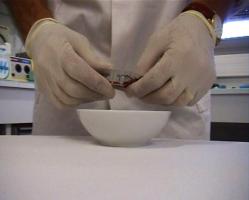
Jeanne Susplugas, Alain DECLERCQ
Plan Iode
| dv | color | 30:0 | France | 2008
Convening the singular universe of two artists, the film "Plan Iode" by Jeanne Susplugas and Alain Declercq, is an enigmatic and anxious vision. Every five years, the army pharmacy distributes throughout offices in France two regulation cartons. In each carton there are 40 bottles of 8 tablets of potassium chloride, a drug that fixes iodine on the thyroids, a vital remedy in case of a nuclear problem. Women and children first, while the rest copes. In the middle of a nuclear scare, everything is allowed from humanism to complicated shrewdness. Filmed in about twenty pharmacies, this film shows the movement of these coveted boxes, leaving some doubt as to their future use. Through an effective panoramic system in the last pharmacies, this film both shows and hides "what happens:" between apocalyptic ghosts and the state of pharmacies today.
Born in 1974 in Montpellier, France, Susplugas lives in Paris. Her work has been shown in Musée d`Art Moderne, St Etienne, France; MOCCA and V-Tape, Toronto; ; Kunst-werke, Berlin; Wyspa Institut of Art, Gdansk, Poland ; Palazzo delle Papesse, Siena ; Fresnoy National Studio, Fresnoy, France; Musée d`Art du Guangdong, Canton; Shangai Biennal; Ulrich Museum of Contemporary Art, Wishita; Villa Medicis, Rome; Careof, Milan; Alexandria Biennal, Egypt; The Korean Culture Service, New York; Ewha Art center, Seoul; Center Soros for Contemporary Art, Kiev; Kunstverein Nuremberg and Hamburg, Germany, among others. Susplugas is represented by galerie Schirman&deBeaucé, Paris ; Think.21 gallery, Brussels ; Florence Lynch gallery, New York ; Mizuma Art gallery, Tokyo. Born in France in 1969, Alain Declercq lives and works in Paris. He has shown few times in Palais de Tokyo, Paris, France; Museum of Modern Art, Paris; Contemporary Art Museum, Taipei, Taiwan; Gallery Vox, Montreal, Canada; Cairo Biennal, Egypt; Transmediale, Berlin, Germany; Lyon biennal, France; Stuttgart Kunstverein, Germany, among others. Declercq is represented by galerie Loevenbruck, Paris, France; Jacky Strenz, Frankfort, Germany.
Eve Sussman, Simon Lee
Catalogue : 2016No Food No Money No Jewels | Video | 4k | color | 9:38 | USA | 2014
Eve Sussman, Simon Lee
No Food No Money No Jewels
Video | 4k | color | 9:38 | USA | 2014
Dialogue is sourced from historical recordings by notorious public figures and performed verbatim within a fictitious factory setting. Problems infiltrate the water factory and life’s ambitions and problems come into play: food must be procured, water is wasted, a worker disappears and another, a mysterious woman –– a provocateur? a spy?––appears, loyalty is questioned, everyone is suspected, the break-room in the factory morphs into a courtroom where eventually everyone pleads the 5th… The public figures (Princess Diana, LBJ, Charlie Watts, John DeLorean, Marcel Marceau, Janice Joplin, Lance Loud and Jimmy Hoffa among many others) remain largely unidentified in NO FOOD NO MONEY NO JEWELS but their spoken characteristics fuel the piece using the themes that emerge from the source texts. Individual notions of labor and economy, conflicting work ethics and responsibility for commodity are addressed through the monologues’ repeated motifs of accusation, denial, betrayal, accountability, implications of guilt and fear mongering.
Eve Sussman is a Brooklyn-based artist and filmmaker who works independently and collectively with her partner Simon Lee and Rufus Corporation, founded in 2003. Along with Rape of the Sabine Women, and 89 Seconds at Alcázar, that debuted at the Whitney Biennial, the company has collaborated on other projects including Yuri’s Office, and whiteonwhite:algorithmicnoir . Rufus Corporation’s works have been exhibited and screened internationally and are included in the collections of the Museum of Modern Art, New York; the Whitney Museum of American Art, New York; the Philadelphia Museum of Art, Philadelphia; The Margulies Collection, Miami; Fundación La Caixa, Barcelona; and Centro Galego de Arte Contemporáneo, Santiago de Compostela, Spain. whiteonwhite:algorithmicnoir was recently acquired for the permanent collection of the Smithsonian American Art Museum. Simon Lee works in photography, video and installation. His work is said to often be “a powerful metaphor for the random flow of history and a low tech formal tour de force” (Holland Cotter, New York Times). His 2010 film collaboration with Algis Kizys, Where is the Black Beast? (2010) was shown at the Sagamore Collection in Miami, Zebra Poetry Film Festival Berlin, IFC Center in New York, and was an official selection at the 2011 Rotterdam Film Festival. Together with Sussman, he co-founded the “Wallabout Oyster Theater,” a micro-theater space run out of their studios in Brooklyn. Lee has exhibited at the Brooklyn Museum of Art; The Berkshire Museum, MA; Roebling Hall, New York; the Moscow International Film Festival; Musée d’Art Contemporain de Montreal; Poznan Biennale, Poland; The Rotunda Gallery, Brooklyn NY; Tinguely Museum, Basel, Switzerland; Espace Paul Ricard, Paris, France; and The Whitney Museum of American Art, New York. In addition to founding the Wallabout Oyster Theatre, Lee + Sussman have been producing for Jack+Leigh Ruby, to ex-con artists who are now directing videos including: Car Wash Incident
Eve Sussman (a.k.a Ife), Simon Lee
Catalogue : 2019No food No money No jewels | Multimedia installation | 0 | color and b&w | 0:0 | USA | 2017
Eve Sussman (a.k.a Ife), Simon Lee
No food No money No jewels
Multimedia installation | 0 | color and b&w | 0:0 | USA | 2017
“No food…†is in post-production as a movie + as a multi-screen installation with each discrete chapter encountered within a built environment. The audience is introduced to a cyclical water-bailing machine: The Factory + the boss (“Rabbitâ€) in charge. Trials + tribulations ensue: in “That`s Easy Init†the boss interrogates the janitors (“Donkey1+2â€) about their moonlighting. In Agent Provocateur two characters disguise themselves for nefarious purposes. “I Thought We Were Going to be Rich†tells the story of a failed burglary. In The Deposition “management†has morphed into prosecutor + council as the workers are questioned about an unsolved disappearance. Rabbit Recipes is a dance reverie + epilogue of sorts as the characters rejoice over a mutiny that results in cooking the boss.
Eve Sussman works with film, video and installation. Her work runs the gambit from small gauge analogue film and multi-camera surveillance operations to hi-def film/video productions. In an attempt to re-invent and push the envelope of the form much of her work experiments with narrative and addresses the question: “What is a movie?â€. She often collaborates with performers, musicians and programmers, sometimes under the name Rufus Corporation. Rufus Corporation works include: 89 seconds at Alcazar, The Rape of the Sabine Women, whiteonwhite:algorithmicnoir and Yuri’s Office. Together with Simon Lee, Sussman co-founded the Wallabout Oyster Theatre, a micro theatre space in Brooklyn. Sussman and Lee are also as producing for Jack+Leigh Ruby, two reformed criminals, now making art. Sussman’s work has been shown in institutions and film festivals internationally. 89 seconds at Alcazar is in the collections of the MoMA, the Whitney and the Leeum–Samsung Museum in Seoul. whiteonwhite:algorithmicnoir is in the collection of the Smithsonian American Art Museum in Washington D.C.
Anocha Suwichakornpong
Catalogue : 2008Graceland | Fiction | 35mm | color | 17:0 | Thailand | 2006
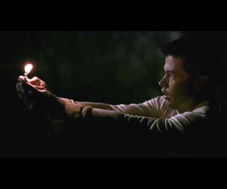
Anocha Suwichakornpong
Graceland
Fiction | 35mm | color | 17:0 | Thailand | 2006
One night in Bangkok, Jon meets a mysterious woman. Together, they embark on a journey to a foreign land - the human heart.
Born in Thailand in 1976, Anocha Suwichakornpong, also known as 'Mai', spent the nineties living in England where she received her BA and MA. In February 2006, she graduated from a MFA film program at Columbia University, New York. In that same month, Anocha attended the Berlinale Talent Campus. Her feature-length script, "The White Room", was among the fifteen scripts chosen to participate in their Script Clinic program. In May 2006, Anocha's thesis, "Graceland" became the first Thai short film to be included in the Official Selection at Cannes Film Festival (Cinéfondation). She is soon to begin pre-production on a series of short films, titled "Like. Real. Love." Currently, Anocha is developing another feature-length script entitled "Jao Nok Krajok" (The Sparrow), which has received the Hubert Bals Fund from the Rotterdam International Film Festival and is one of twenty-five projects selected for HAF ? Hong Kong Film Financing Forum 2007. A former art and cultural studies student, Anocha's interest in film extends beyond the visual aspects of the medium. She views film as a language, with its own codes and representation. However, she fervently believes that great cinema can transcend the language barrier, in all senses of the term. Film can only be meaningful if it contains truth ? and not just cinematic truth. In other words, it must speak about human condition.
Ondrej Svadlena
Catalogue : 2008SANITKASAN | Animation | betaSP | color | 7:34 | Czech Republic | 2007
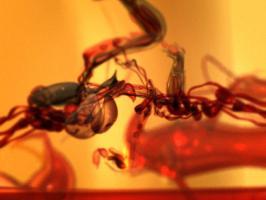
Ondrej Svadlena
SANITKASAN
Animation | betaSP | color | 7:34 | Czech Republic | 2007
Sanitkasan is a short film/audiovisual work about strange beings in interrelated worlds, trying to escape the inevitable. It explores in metaphorical ways a loop of events where various entities are trapped in their ever-repeating actions and questions the degree of freedom in the freedom of choice. It?s a sweet-sour jelly. The 3d pieces directly result from a long-term preoccupation with the means of drawing, by which I first build the different parts, worlds, subjects, creatures. I work with visions as serial images and moods often accompanied by accoustic backgrounds, developing for each piece a special metaphorical audio-visual language. These visions evolve in my mind - just like dreams, or daydreams. I then transpose those by audiovisual means.
nouvelle bio: Ondrej Svadlena was born in Czechoslovakia on April 6th 1978. In 1984 he escaped on foot across the jugoslavian-austrian border with his mother and step-father. After waiting for 6 months in Austria they were granted political asylum in Canada. Ondrej had a peaceful childhood in Hull, Aylmer and Montreal in the province of Quebec until 1991 when he moved to Munich, Germany with his family. After his Bac in 1996, he moved to Bruxelles to study illustration and comics. In 1997 he moved to the Czech Republic to study film and television graphics at the Academy of Art Architecture and Design in Prague where he completed his studies with a Master of Art in 2003. As a fresh graduate he moved back to Montreal, and after a month of unsuccessful jobseeking, he ended up working as a construction/renovation worker. Since 2005, Ondrej Svadlena is back in Prague where he is employed as a 3D animator, and works on his personal projects in his spare time (often in the small village of Palcano in Italy). ***** Born 06.04.1978 in Benesov, Czechoslovakia 1984 Escape to Austria 1985 - 1991 Living in the province of Quebec, Canada 1991 - 1996 Living in Munich, Germany 1996 - 1997 Academie Royale des Beaux-Arts, Bruxelles, Belgium Department of Illustration and Comics 1997 - 2003 Academy of Art, Design and Architecture, Prague, Czech Republic Department of Film and Television Graphics. Professor: Jiri Barta 2003 Master of Arts 2003 - 2004 Construction and renovation work, Montreal, Canada from 2005 living and working in Prague Artist/3D animator/Director, Avion Postproduction, Prague, Czech Republic
Katherine Sweetman
Catalogue : 2008Swimming with Rosemary | Documentary | dv | color | 41:33 | USA | 0
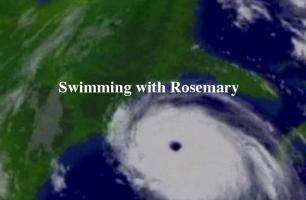
Katherine Sweetman
Swimming with Rosemary
Documentary | dv | color | 41:33 | USA | 0
Swimming with Rosemary (2007): Rosemary and her boyfriend lived in New Orleans during the devastation of Hurricane Katrina. They chose to remain in New Orleans through the storm and its aftermath. After a five-day, paranoid, militant, stakeout of their home, they decided to leave. The power was out; there were shootings and explosions in their neighborhood. They believed that the military was bombing the Superdome to stop the looters. Conspiracy theories and rumors escalated in their neighborhood, and there was no communication from the outside world to stop the rumors. They believed that their lives were in danger, so they packed-up some belongings, water, and their dogs, and they tried to evacuate. They found a truck and drove through the waterlogged streets of New Orleans. They had to fend off mobs of ?zombies? trying to attack them and steal the truck. The truck finally broke down on an overpass just outside of the city. They sat there for a day and a night trying to get a ride. When a ride finally came, it took them to a ranch on the outskirts of Houston, Texas. The ranch was owned by a Church Pastor, and he convinced them that if they were going to sleep in the same bed, they should go ahead and get married. This could be a beautifully romantic story except for the fact that this man, her boyfriend (and now her husband), is an extremely abusive alcoholic with very violent tendencies. The two were married in this evacuee camp / ?Christian Revival Ranch? by the Pastor about a week and a half after the hurricane destroyed their home, their city, and Rosemary?s life. Six months after Hurricane Katrina leveled areas of New Orleans, I flew Rosemary and myself back to the city to re-trace her evacuation route, visit her former home, and make a documentary about her escape. At least this is what I told her that the documentary was about. My true intention was to convince her to leave her abusive husband. I had heard too many horrible stories, and I needed to see her. I needed to convince her that she was capable of leaving him and that leaving him was the only thing to do. Our journey begins in the airport in New Orleans (January 2006). We go to Bourbon Street and fall into the same roles that we had when we were best friends back in our late high school/early college years. We take the Greyline Bus Katrina ?Damage Tour?, go to her former home, drive up the overpass, and talk. But for some reason, it became increasingly difficult to discuss her relationship with this man on camera and off, and I found myself avoiding the subject and feeling uneasy about the whole idea. I took her to Houston, and we visited the Pastor and his family. We saw the church where they had been married and the stage where they stood and gave their wedding vows. The last day of our journey I took her to a counselor-- in some last, vain attempt at an intervention.
My background centers on film studies, video, and experimental communications projects. As a result, my first year and a half of work at the Visual Arts Facility, UCSD, has produced three, very personal documentary films concerning my family, close friends, and myself. The issue then quickly became, why do I want to expose these very personal issues to the public? What is the human drive to do that type of act? My work has since become an investigation of that question. Beyond myself, why do others expose themselves to the public and what are the means through which we all do this?
Corin Sworn, Tony Romano
Catalogue : 2017The Coat | Experimental fiction | 4k | color | 57:58 | United Kingdom | 2016
Corin Sworn, Tony Romano
The Coat
Experimental fiction | 4k | color | 57:58 | United Kingdom | 2016
The Coat loosely adapts Aristophanes’ The Birds from the Athens of 414 BC to contemporary Calabria. Here the two people who leave their home looking for a better life are a young man and his daughter arriving from Albania in search of a swimming coach who fled the collapse of Communism in the 1990s. They search for the coach among Italy’s Arboresh community, descendants of an earlier Albanian exodus of the 1450s. Along the way the pair intercept two actors touring the rural south in an attempt to resuscitate the long dead street hero Punchinella. Here histories are invoked only to be folded in on themselves and diffused back through the Calabrian landscape. The characters, naive to the terrain that surrounds them rely predominantly on cartographies of their own desire while the birds fly overhead taunting their imprudence. Co written with, and employing professional and amateur actors, The Coat’s itinerant figures don’t so much drive narrative as walk it slowly along.
CORIN SWORN was born in London, England, and raised in Toronto. She studied psychology and integrated media before earning her master’s at the Glasgow School of Art. Sworn has exhibited internationally, including at the Whitechapel Gallery, Tate Britain, the National Gallery of Canada, and the 2013 Venice and Sydney Biennials. Her film work has appeared at Rotterdam Film Festival and the Centre Pompidou. TONY ROMANO was born in Toronto and earned his B.F.A. from the Emily Carr Institute of Art and Design. His film installations have been exhibited internationally, with solo and group shows at MoMA, Night Gallery in Los Angeles, Articule in Montreal, Kulturhuset in Stockholm, and MOCCA and The Power Plant in Toronto.
Telco Systems, Longina
Catalogue : 2006Oidar | Experimental video | dv | black and white | 2:0 | Netherlands | 2005

Telco Systems, Longina
Oidar
Experimental video | dv | black and white | 2:0 | Netherlands | 2005
Oidar (2`, 2004) Digital film, specially made for the Cronica 021-2005 DVD: "Can I have 2 minutes of your time?". All Images by Telcosystems Audio by Longina
Telcosystems Lucas van der Velden and Gideon Kiers are the founding members of Telcosystems. Lucas van der Velden (1976, Eindhoven) lives and works in Rotterdam. Gideon Kiers (1975, Amsterdam) lives and works in Rotterdam and Reykjavik. Both studied at the Interfaculty Image and Sound, a department at the Royal Conservatory and the Royal Academy in The Hague. They started the Telcosystems in 2001 to explore new modes of audiovisual expression. They are also initiators of 0010, minuszero, D:U:M:B and DLF and members of the curatorial team for the Sonic Acts festival in Amsterdam.
Illya Szilak, Tsiboulski
Catalogue : 2025Queerskins: Fly Angel Soul | Experimental film | mp4 | color and b&w | 21:2 | USA | 2024
Illya Szilak, Tsiboulski
Queerskins: Fly Angel Soul
Experimental film | mp4 | color and b&w | 21:2 | USA | 2024
FLY ANGEL SOUL recounts the story of Sebastian, a young gay physician estranged from his Missouri Catholic family who dies of AIDS in Mali, having lived a peripatetic life searching for acceptance and a place to call home. Drawing on our experience as interactive VR storytellers (Queerskins: A Love Story, Queerskins: ARK, QuillsFest VR world), we created a bold cinematic language made possible only through virtual production. This language forefronts gestural camerawork, multiple perspectives, and elements of dance film, theater, and video games. Using Unity game engine and Cinemachine tools and the directors’ descriptions, lead engineer Elliott Mitchell created three types of “embodied” virtual cameras: a fly, an angel, and a human/soul, each of which sees and moves through the responsive virtual mis-en-scene differently. Although our film privileges the human space-time perspective, it allows the audience to experience alternative, computer-mediated ways of perceiving the same story. All three cameras function as the “players,” both in the video game and theatrical sense. The cameras’ real-time “performance” is documented as footage edited to create the final film. Both the fly and the angel cams are purely virtual. The “soul” cam path, however, was based on the real-time experience of creative technologist, dancer, and artist Clemence Debaig who was asked to move through the virtual set with the mindset of certain characters e.g. Sebastian’s estranged but loving mother, his cold and distant father, and as herself, a “neutral” observer. Debaig's decisions regarding how she moved through the environments and interacted with the virtual sets determined what was captured in real-time as 2D film footage by the “soul cam” programmed to follow her path and speed. In agreement with Vivian Sobchack’s description of the film camera as perceiving “subject,” we propose that our soul cam acts like a virtual cinematic avatar, allowing viewers to actively participate in the narrative as it navigates the responsive mis-en-scene. mbracing the visual language of spatial computing and video game, the film is constructed as a journey. There is little plot. In place of action, Sebastian’s acceptance of himself as a gay man and a Christian evolves. To allow Sebastian's interior state to manifest outwardly in a way that could be “lived" by film viewers, the story is revealed and experienced by movement through dream-like architecture and landscapes created in collaboration with fine artist Paolo Barlascini.
llya Szilak is an independent scholar, writer and new media artist. In her art practice, she uses open source media and collaborations forged via the Internet to create multimedia narrative installations online. Shaped by her experience as a physician, her artistic practice explores mortality, embodiment, identity, and belief in a media inundated by an increasingly virtual world. Cyril Tsiboulski is her interactive designer/ collaborator. Her first work Reconstructing Mayakovsky was included in the second Electronic Literature Collection and has been taught both as an example of innovative narrative game and literature at the university level. Her second work Queerskins was included in the third Electronic Literature Collection. She is currently working on Atomic Vacation, a post-apocalyptic narrative journey through virtual landscapes. She writes frequently in the popular press on new media art and electronic literature. Please join her September 10th from 1-6 PM at The Kitchen in NYC for the event she is curating: Electronic Literature: We Have Always Been Digital. This afternoon of interactive presentations showcases a range of dynamic forms from bots and games to interactive online works, and offers audience members the chance to engage with works and authors after the performances.